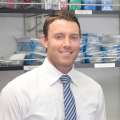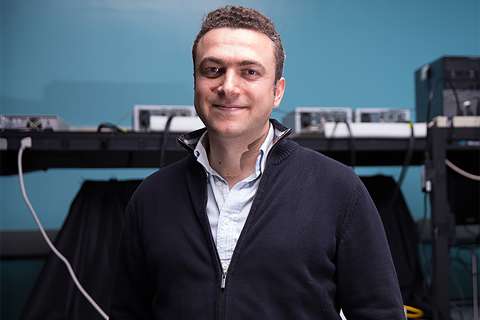A diverse team of scientists from UCLA's Jonsson Comprehensive Cancer Center has developed an experimental treatment that eradicates an acute type of leukemia in mice without any detectable toxic side effects. The drug works by blocking two important metabolic pathways that the leukemia cells need to grow and spread.
The study, led by Dr. Caius Radu, an associate professor of molecular and medical pharmacology at UCLA, and Dr. David Nathanson, an assistant professor of molecular and medical pharmacology, was published in the Journal of Experimental Medicine.
Elements of metabolism called biosynthetic pathways allow cells to synthesize chemicals, called nucleotides, that they need to survive. When these nucleotide pathways are blocked by drug molecules, cancer cell growth can be halted, which can trigger cell death.
Radu, Nathanson and their colleagues found that an important nucleotide called deoxycytidine triphosphate (dCTP) is produced by two pathways, the de novo pathway and the nucleoside salvage pathway.
When an existing drug was given that blocks the de novo pathway in a leukemia cell, the dCTP nucleotide was still produced by the nucleoside salvage pathway, and the leukemia cell survived.
To counter this switch to the alternative pathway, the researchers also administered a small-molecule drug called DI-39 — developed exclusively at UCLA — which blocks the nucleoside salvage pathway. When both of the drugs are given, both pathways are blocked, the leukemia cells cannot produce dCTP nucleotides and the cells die.
In the study, the experimental treatment was given to mice with acute lymphoblastic leukemia, a deadly blood cancer. The treatment eradicated the cancer cells, leaving healthy blood cells alone, and the mice suffered no discernible side effects.
"All cancer cells utilize these two pathways, and they have a strong avidity for these nucleotides to synthesize their DNA or repair it," Nathanson said. "Thus, we believe that this treatment strategy might be applicable across other hematological malignancies besides leukemia."
"Usually people say that drug discovery and development cannot happen strictly in the academic environment — that discovery should be done in academia, and development done elsewhere, such as in industry," said Radu, who also has an appointment in UCLA's interdepartmental program in biomedical physics. "With this study, we show that everything can be done in the academic environment. We started this project from scratch and, with the help of UCLA scientists from many different disciplines, we have taken the drug through all the steps, and now it's nearly ready for clinical trials."
Among the study's many UCLA collaborators were Dr. Michael Phelps, Norton Simon Professor and chair of molecular and medical pharmacology; Michael Jung, distinguished professor of chemistry and biochemistry; Harvey Herschman, distinguished professor and vice chair of molecular and medical pharmacology and distinguished research professor of biological chemistry; Kym Faull, professor of psychiatry and biobehavioral sciences; and Dr. Johannes Czernin, professor of medicine and director of the nuclear medicine clinic.
This research was supported by the UCLA Scholars in Oncologic Molecular Imaging program, the Jonsson Comprehensive Cancer Center at UCLA, and the National Cancer Institute of the National Institutes of Health.





